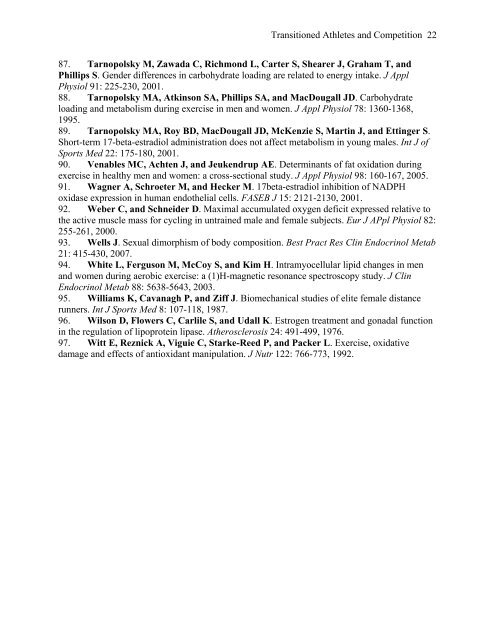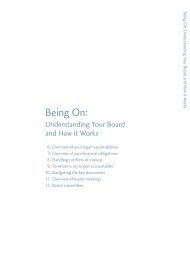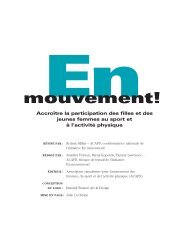Do Transitioned Athletes Compete at an Advantage or Disadvantage
Do Transitioned Athletes Compete at an Advantage or Disadvantage
Do Transitioned Athletes Compete at an Advantage or Disadvantage
Create successful ePaper yourself
Turn your PDF publications into a flip-book with our unique Google optimized e-Paper software.
<strong>Tr<strong>an</strong>sitioned</strong> <strong>Athletes</strong> <strong>an</strong>d Competition 22<br />
87. Tarnopolsky M, Zawada C, Richmond L, Carter S, Shearer J, Graham T, <strong>an</strong>d<br />
Phillips S. Gender differences in carbohydr<strong>at</strong>e loading are rel<strong>at</strong>ed to energy intake. J Appl<br />
Physiol 91: 225-230, 2001.<br />
88. Tarnopolsky MA, Atkinson SA, Phillips SA, <strong>an</strong>d Mac<strong>Do</strong>ugall JD. Carbohydr<strong>at</strong>e<br />
loading <strong>an</strong>d metabolism during exercise in men <strong>an</strong>d women. J Appl Physiol 78: 1360-1368,<br />
1995.<br />
89. Tarnopolsky MA, Roy BD, Mac<strong>Do</strong>ugall JD, McKenzie S, Martin J, <strong>an</strong>d Ettinger S.<br />
Sh<strong>or</strong>t-term 17-beta-estradiol administr<strong>at</strong>ion does not affect metabolism in young males. Int J of<br />
Sp<strong>or</strong>ts Med 22: 175-180, 2001.<br />
90. Venables MC, Achten J, <strong>an</strong>d Jeukendrup AE. Determin<strong>an</strong>ts of f<strong>at</strong> oxid<strong>at</strong>ion during<br />
exercise in healthy men <strong>an</strong>d women: a cross-sectional study. J Appl Physiol 98: 160-167, 2005.<br />
91. Wagner A, Schroeter M, <strong>an</strong>d Hecker M. 17beta-estradiol inhibition of NADPH<br />
oxidase expression in hum<strong>an</strong> endothelial cells. FASEB J 15: 2121-2130, 2001.<br />
92. Weber C, <strong>an</strong>d Schneider D. Maximal accumul<strong>at</strong>ed oxygen deficit expressed rel<strong>at</strong>ive to<br />
the active muscle mass f<strong>or</strong> cycling in untrained male <strong>an</strong>d female subjects. Eur J APpl Physiol 82:<br />
255-261, 2000.<br />
93. Wells J. Sexual dim<strong>or</strong>phism of body composition. Best Pract Res Clin Endocrinol Metab<br />
21: 415-430, 2007.<br />
94. White L, Ferguson M, McCoy S, <strong>an</strong>d Kim H. Intramyocellular lipid ch<strong>an</strong>ges in men<br />
<strong>an</strong>d women during aerobic exercise: a (1)H-magnetic reson<strong>an</strong>ce spectroscopy study. J Clin<br />
Endocrinol Metab 88: 5638-5643, 2003.<br />
95. Williams K, Cav<strong>an</strong>agh P, <strong>an</strong>d Ziff J. Biomech<strong>an</strong>ical studies of elite female dist<strong>an</strong>ce<br />
runners. Int J Sp<strong>or</strong>ts Med 8: 107-118, 1987.<br />
96. Wilson D, Flowers C, Carlile S, <strong>an</strong>d Udall K. Estrogen tre<strong>at</strong>ment <strong>an</strong>d gonadal function<br />
in the regul<strong>at</strong>ion of lipoprotein lipase. Atherosclerosis 24: 491-499, 1976.<br />
97. Witt E, Reznick A, Viguie C, Starke-Reed P, <strong>an</strong>d Packer L. Exercise, oxid<strong>at</strong>ive<br />
damage <strong>an</strong>d effects of <strong>an</strong>tioxid<strong>an</strong>t m<strong>an</strong>ipul<strong>at</strong>ion. J Nutr 122: 766-773, 1992.






